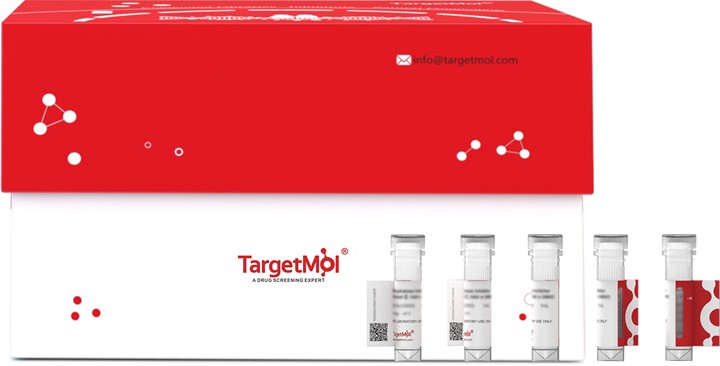Shopping Cart
Remove All Your shopping cart is currently empty
Your shopping cart is currently empty
Tumor Necrosis Factor Receptor Superfamily Member 10C (TNFRSF10C) is a glycosyl-phosphatidylinositol-linked membrane protein which binds TRAIL with high affinity. TNFRSF10C has the TRAIL-binding extracellular cysteine-rich domains, lacks the intracellular signaling domain. As a result, binding of TRAIL to TRAIL R3 doesn't transduce an apoptosis signal. The expression of TRAIL R3 gene has been shown to protect cells bearing TRAIL R1 and/or TRAIL R2 from TRAIL-induced apoptosis.

| Pack Size | Price | USA Warehouse | Global Warehouse | Quantity |
|---|---|---|---|---|
| 5 μg | $39 | 7-10 days | 7-10 days | |
| 10 μg | $60 | 7-10 days | 7-10 days | |
| 20 μg | $96 | 7-10 days | 7-10 days | |
| 50 μg | $183 | 7-10 days | 7-10 days | |
| 100 μg | $285 | 7-10 days | 7-10 days | |
| 200 μg | $445 | 7-10 days | 7-10 days | |
| 500 μg | $806 | 7-10 days | 7-10 days | |
| 1 mg | $1,060 | 7-10 days | 7-10 days |
| Biological Activity | Activity has not been tested. It is theoretically active, but we cannot guarantee it. If you require protein activity, we recommend choosing the eukaryotic expression version first. |
| Description | Tumor Necrosis Factor Receptor Superfamily Member 10C (TNFRSF10C) is a glycosyl-phosphatidylinositol-linked membrane protein which binds TRAIL with high affinity. TNFRSF10C has the TRAIL-binding extracellular cysteine-rich domains, lacks the intracellular signaling domain. As a result, binding of TRAIL to TRAIL R3 doesn't transduce an apoptosis signal. The expression of TRAIL R3 gene has been shown to protect cells bearing TRAIL R1 and/or TRAIL R2 from TRAIL-induced apoptosis. |
| Species | Human |
| Expression System | HEK293 Cells |
| Tag | C-hFc-6xHis |
| Accession Number | O14798 |
| Synonyms | Tumor Necrosis Factor Receptor Superfamily Member 10C,TRAIL Re,TNF-Related Apoptosis-Inducing Ligand Receptor 3,Lymphocyte Inhibitor of TRAIL,Decoy TRAIL Receptor Without Death Domain,Decoy Receptor 1,DcR1,Antagonist Decoy Receptor for TRAIL/Apo-2L |
| Amino Acid | Ala26-Ala221 |
| Construction | Ala26-Ala221 |
| Protein Purity | Greater than 95% as determined by reducing SDS-PAGE. (QC verified) |
| Molecular Weight | 90 KDa (reducing condition) |
| Endotoxin | < 0.1 ng/µg (1 EU/µg) as determined by LAL test. |
| Formulation | Lyophilized from a solution filtered through a 0.22 μm filter, containing PBS, pH 7.4. |
| Reconstitution | Reconstitute the lyophilized protein in distilled water. The product concentration should not be less than 100 μg/ml. Before opening, centrifuge the tube to collect powder at the bottom. After adding the reconstitution buffer, avoid vortexing or pipetting for mixing. |
| Stability & Storage | Lyophilized powders can be stably stored for over 12 months, while liquid products can be stored for 6-12 months at -80°C. For reconstituted protein solutions, the solution can be stored at -20°C to -80°C for at least 3 months. Please avoid multiple freeze-thaw cycles and store products in aliquots. |
| Shipping | In general, Lyophilized powders are shipping with blue ice. Solutions are shipping with dry ice. |
| Research Background | Tumor Necrosis Factor Receptor Superfamily Member 10C (TNFRSF10C) is a glycosyl-phosphatidylinositol-linked membrane protein which binds TRAIL with high affinity. TNFRSF10C has the TRAIL-binding extracellular cysteine-rich domains, lacks the intracellular signaling domain. As a result, binding of TRAIL to TRAIL R3 doesn’t transduce an apoptosis signal. The expression of TRAIL R3 gene has been shown to protect cells bearing TRAIL R1 and/or TRAIL R2 from TRAIL-induced apoptosis. |
| Size | Quantity | Unit Price | Amount | Operation |
|---|

Copyright © 2015-2025 TargetMol Chemicals Inc. All Rights Reserved.